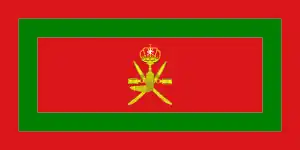| Said bin Ahmed | |
|---|---|
| Sultan of the Omani Empire | |
| Reign | 1783–1786 |
| Predecessor | Ahmad bin Said al-Busaidi |
| Successor | Hamad bin Said |
| Died | 1803 Al-Batinah Fort, Rustaq |
| Burial | Al-Batinah Fort, Rustaq |
| Dynasty | Al Said |
| Father | Ahmad bin Said al-Busaidi |
| Mother | Ghani bint Khalfan Al-Busaidiyah |
Said bin Ahmad (died 1803) was briefly the Imam and Sultan of Oman, the second of the Al Said dynasty, ruling the country between 1783 and 1786.
Rule
Said bin Ahmad was the son of the Imam and Sultan Ahmad bin Said al-Busaidi, and was elected Imam on his father's death in 1783. The succession was unchallenged, and Said took possession of the capital, Rustaq.
His brothers Saif and Sultan bin Ahmad called on Sheikh Sakar of the Shemal tribal group to help them gain the throne.
Sheikh Sakar took the towns of Hamra, Shargah, Rams and Khor Fakan. Said fought back, but was unable to regain these towns.
However, Saif and Sultan felt it was too dangerous for them to stay in Oman. Saif sailed for East Africa, intending to set himself up as a ruler there.[1] He died there soon after. Sultan escaped to Gwadar on the Makran coast of Balochistan.[2]
Deposition
The Imam was increasingly unpopular. Around the end of 1785 a group of notables elected his brother, Qais bin Ahmad, Imam. This revolt soon collapsed.[3]
Later one of Said‘s sons was held prisoner in Fort Al Jalali for a period by the governor of Muscat. Another son, Hamad bin Said, came to negotiate with the governor. Hamad and his followers managed to gain control of forts al-Jalali and al-Mirani, and thus of Muscat.[4]
This happened in 1786. One by one the other fortresses in Oman submitted to Hamad, until Said no longer had any temporal power.[5]
Hamad took the title of Sheikh and established his court in Muscat. Said bin Ahmad remained in Rustaq and retained the title of Imam, but this was purely a symbolic religious title that carried no power.[6]
References
Citations
- ↑ Miles 1919, p. 281.
- ↑ Miles 1919, p. 282.
- ↑ Miles 1919, p. 282-283.
- ↑ Peterson 2007, p. 72.
- ↑ Miles 1919, p. 283.
- ↑ Thomas 2011, p. 224.
Sources
- Miles, Samuel Barrett (1919). The Countries and Tribes of the Persian Gulf. Garnet Pub. ISBN 978-1-873938-56-0. Retrieved 19 November 2013.
- Peterson, John (2007). Historical Muscat: An Illustrated Guide and Gazetteer. BRILL. ISBN 978-90-04-15266-3. Retrieved 2013-11-16.
- Thomas, Gavin (2011-11-01). The Rough Guide to Oman. Penguin. ISBN 978-1-4053-8935-8. Retrieved 2013-11-11.
